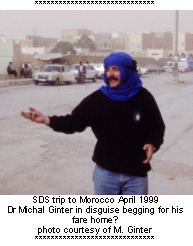|
|
middlePalaeozoic correlation chart for the
Asian sector of north Gondwanaland for
presentation at the meeting in Pakistan in
1999. This project will greatly assist in
resolving complex stratigraphic alignments in
an region poorly understood at the start of
IGCP421.
There were two other conference
field trips: a one day trip (Dec. 14) to
Devonian sections at Chah-Riseh close to
Isfahan, and following on from the conference
we travelled on Dec. 15 by coach to an
overnight stay in Shiraz after a dusk visit to
the ruins of Pasargade (the ancient capital of
Cyrus the Great). On the morning of Dec. 16
we visited Naght-e-Rostam (where tombs
attributed to Xerxes, Darius I, Darius II and
Artaxerxes are located) and finally the fabled
Persepolis. Eventually we set off for Kerman
(800 km) by coach, passing first the salt
Tashk Lake east of Shiraz and crossing the
Zagros front via Neyriz and Sirjan before
being welcomed in the wee hours by Mike
Bassett and Mohammad Dastanpour. In the
Kerman region, our accommodation was in
University guest houses, and we all enjoyed
typical Persian breakfasts and delightful
Persian meals in the evenings.
Finally came a 4-day field trip in the
Kerman region (17-20 Dec.) examining
primarily Devonian sequences yielding new
macrofossil data. We visited sections at
Gerik, Shams Abad, Hutk and Bidu, all
exposing largely late Devonian strata with rich
coral, brachiopod and stromatoporoid faunas.
One cultural highlight was a visit to the mud
city of Bam (famous for its black dates)
where eucalypts, casuarinas and mimosas
thrive in the fertile and well-watered
environment. En route to Bam, we visited the
Dorah Shah Cambrian limestone with its rich
trilobite and stromatolite remains, and some
delegates were able to study the nearby fish-
bearing Late Devonian strata. In Kerman, we
visited the offices of the Geological Survey
and were able to organise purchase of
obscure Iranian geological literature.
The logistical difficulties of
organising an international conference and
field trips in a nation that has been isolated
from much of the rest of the world for many
years are immense. The hunger for
international scientific collaboration and
literature was obvious; Universities, the
Geological Survey of Iran, and numerous
mines welcomed delegates and participated in
the venture by organising local IGCP421
meetings, discussion groups, tours, or by
simply hosting a function. Some delegates
were interviewed by a range of media; all were
welcomed into laboratories, shown numerous
specimens, engaged in endless discussion by
eager students, and overwhelmed by
hospitality. Almost every delegate enjoyed
the hospitality of the GSI in Tehran, and
many visited their offices and held
discussions with Iranian colleagues. The
success of this venture was a great
illustration of the value of UNESCO's IGCP
|
|
|
|
program. We salute our Iranian hosts and
IGCP leaders, and thank them for this
marvellous opportunity. A meeting volume is
expected to appear in the supplement series
to the Records of the Western Australian
Museumlate in 2000.
From the Isfahan Abstracts volume:-
Hairapetian, V. & Gholamalian, H. 1998. First
report on the Late Devonian fish remains
and microvertebrate fragments in the
Chahriseh area, north east of Esfahan,
Iran. In Mawson, R., Talent, J., Wilson, G.
& Cockle, P. (Editors) Abstract Book,
Isfahan Meeting IGCP 421, North
Gondwanan mid-Palaeozoic
bioevent/biogeography patterns in relation
to crustal dynamics. p. 15
Hampe, O. 1998. Remains of Phoebodus
from the Upper Devonian (Middle
Famennian) of northwestern Iran
(Chondrichthys; Elasmobranchii). Op. cit.,
p. 16.
Schultze, H-P. Fishes from the Lower
Devonian of the Canadian Arctic. Op. cit.,
p. 32.
Yazdi, M. & Turner, S. 1998. Vertebrates
from the Early Carboniferous of the
Shotori Range, Tabas, eastern Iran. Op.
cit., 42-43.
Yazdi, M., Turner, S. & Manani, M. 1998.
Discovery of new conodont and
microvertebrate remains in the Late
Devonian of the Shotori Range, eastern
Iran. Op. cit., p. 43.
Young, G.C. 1998. North Gondwana Mid-
Palaeozoic connections with Euramerica
and Asia: Devonian vertebrate evidence.
Op. cit., 44-45.
John Long, Western Australian Museum
Andrew Simpson, Macquarie University
Tony Wright, University of Wollongong
Gavin Young, Australian National University
|
|


 1
2
3
4
5
6
7
8
9
10
11
12
13
14
15
16
17
18
19
20
21
22
23
24
25
26
27
28
29
30
31
32
33
34
35
36
37
38
39
40
41
42
43
44
45
46
47
48
1
2
3
4
5
6
7
8
9
10
11
12
13
14
15
16
17
18
19
20
21
22
23
24
25
26
27
28
29
30
31
32
33
34
35
36
37
38
39
40
41
42
43
44
45
46
47
48



 1
2
3
4
5
6
7
8
9
10
11
12
13
14
15
16
17
18
19
20
21
22
23
24
25
26
27
28
29
30
31
32
33
34
35
36
37
38
39
40
41
42
43
44
45
46
47
48
1
2
3
4
5
6
7
8
9
10
11
12
13
14
15
16
17
18
19
20
21
22
23
24
25
26
27
28
29
30
31
32
33
34
35
36
37
38
39
40
41
42
43
44
45
46
47
48

